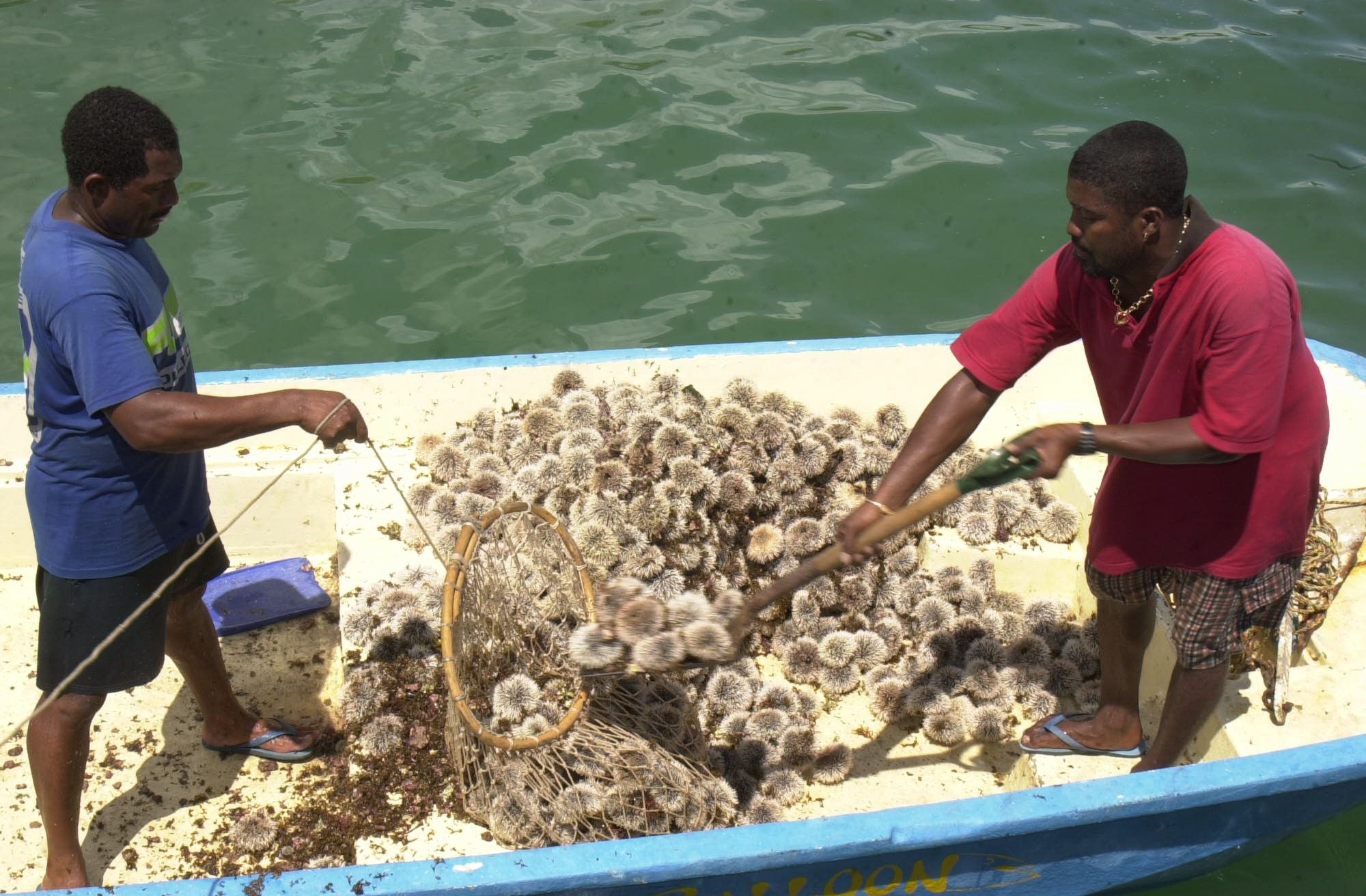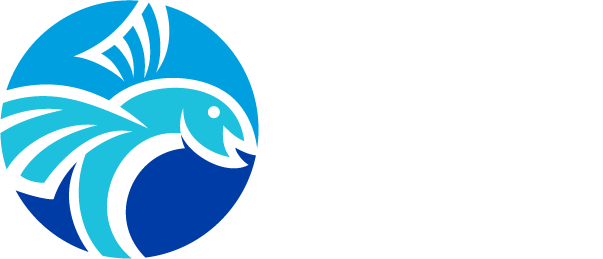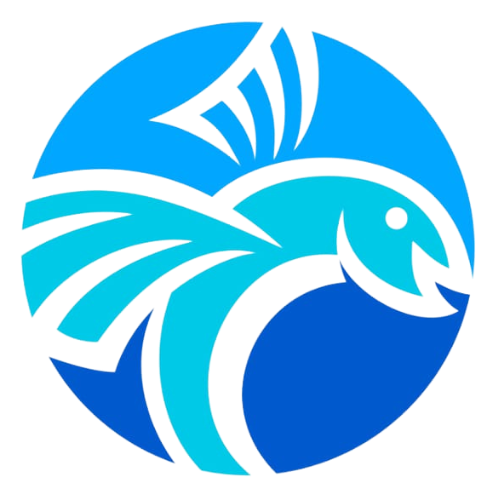Author: Mr. Christopher Parker (Deputy Chief Fisheries Officer)
The Biology of the Sea Egg
Sea eggs (Tripneustes ventricosus) are members of the phylum Echinodermata, which literally means “spiny skin”. More specifically, sea eggs fall within a smaller class of the echinoderms known as regular echinoids more commonly known as regular sea urchins. Like all echinoderms, sea eggs have a penta-radial symmetrical body plan. This simply means that the body appears to be divided into five, more or less, identical sections arranged around a central axis. The external shell of a sea urchin, known as the test, is composed of a number of fused calcareous (i.e. mainly composed of calcium carbonate) plates. The plates are arranged into two distinct groups or series, known as the ambulacral (derived from the word ambulate meaning to walk) and the inter-ambulacral series. The five ambulacral and five inter-ambulacral series are arranged alternately in the characteristic penta-radial pattern of the group (Figure 1).
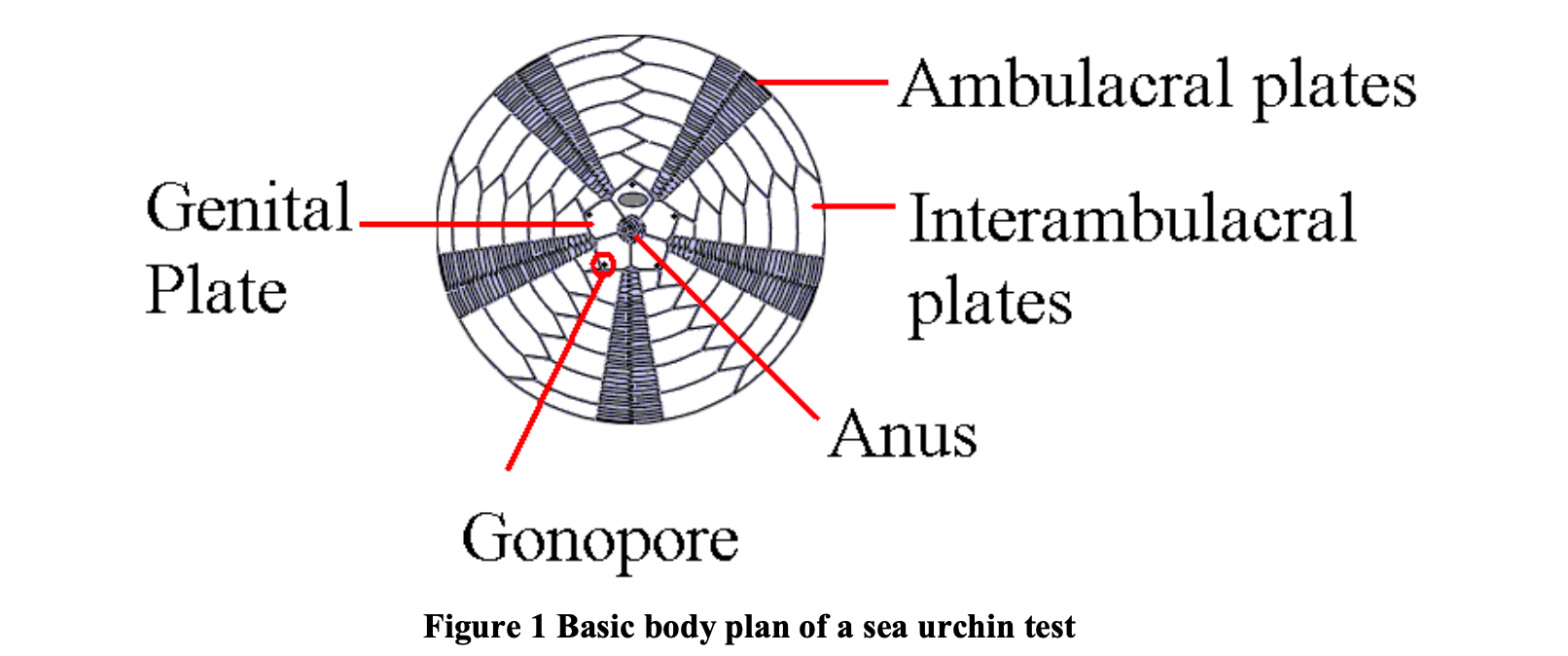
The sea egg test is riddled with a myriad of tiny holes through which small pockets of the soft tissue that lines the inside of the test, protrude to form specialised locomotory structures known as tube feet. The spines are slender calcareous outgrowths of the outer surface of the test plates. In addition to their obvious use in defense against attackers, the spines are also used to assist in the movement of the sea egg. Spines and tube feet are present over the entire surface of the test. However a greater number of tube feet and fewer, smaller spines are located in the ambulacral plates with larger spines and fewer tube feet in the interambulacral plates.
The inside of the sea egg’s test is filled with fluid in which the internal organs are suspended. The mouth is protrusible (i.e. can be pushed forward) to facilitate grazing and is located at the center of the lower (or oral) side of the test. The mouth is a complex organ composed of a number of calcareous structures that articulate together to grind and drag food into the animal’s digestive tract. The whole structure is known as the Aristotle’s lantern (Figure 2) as it is said to resemble an old-fashioned oil lamp and bears the name of the famous philosopher who first described it. The anus is located in the center of the upper or aboral side of the animal. The gonads (testes or ovaries) of a sea egg are five-lobed structures that are attached to the top inside of the shell along theinteramubulacral plate series (Figure 3). Each lobe of the gonad opens to the outside by way of a duct (Figure 4) leading to a small hole in the test called a gonopore through which the eggs or sperm are expelled into the water during spawning (Figure 1).
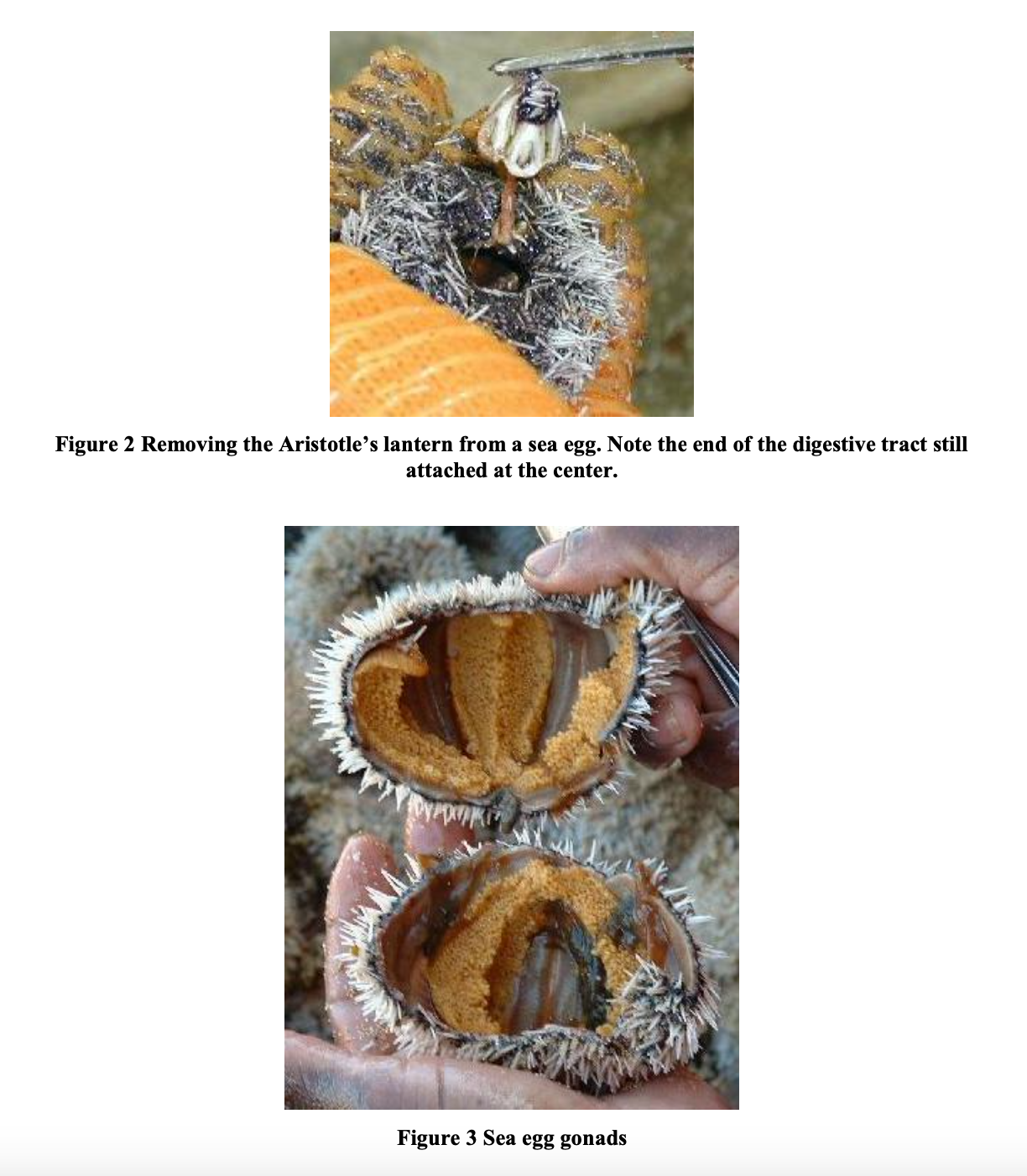
Sea eggs are common coastal inhabitants of the central Atlantic Ocean. The species geographic range extends from the West African coast to the Gulf of Mexico, as far south as Brazil and as far north as the Carolinas. Around Barbados, sea eggs tend to be most abundant along the southeast and northern coasts of the island.
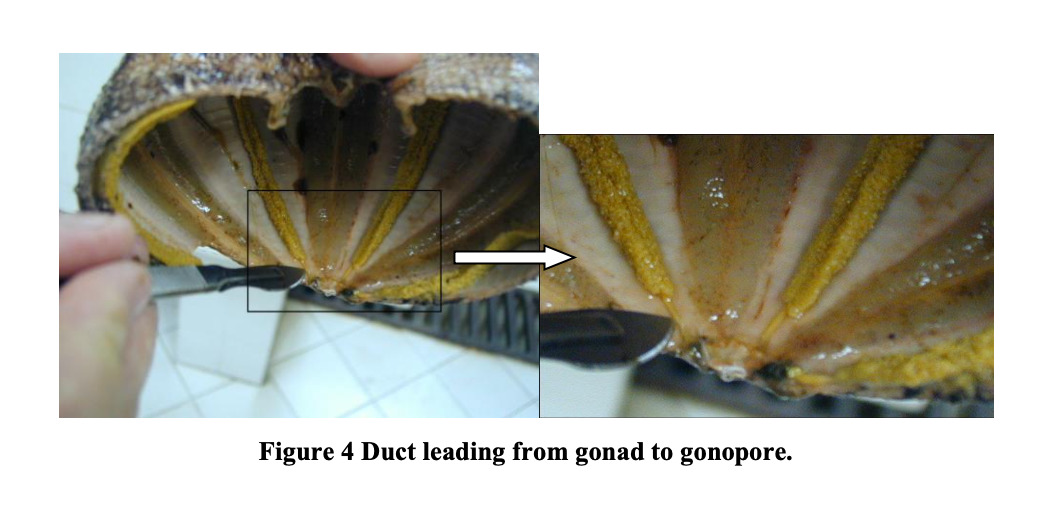
There are no external features that may be used to identify the sex of a sea egg. However, the spawn produced by males and females usually differs in colour. Male spawn is usually yellow while female spawn is usually a deeper orange in colour (Figure 5).
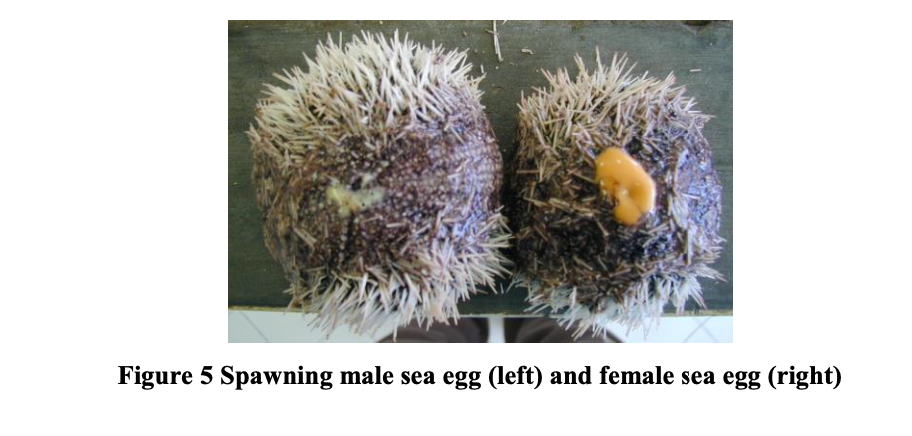
A diagrammatic summary of the life cycle of a sea egg is presented in figure 6. Adult sea eggs shed their gametes (eggs or sperm) directly into the water where fertilization and subsequent embryonic development occurs. The organism undergoes several changes in form during its embryonic development in the water. After 2 days the larva starts to feed. Eventually the larva settles to the seafloor and undergoes a rapid transformation (metamorphosis) into what is commonly identifiable as a sea egg.
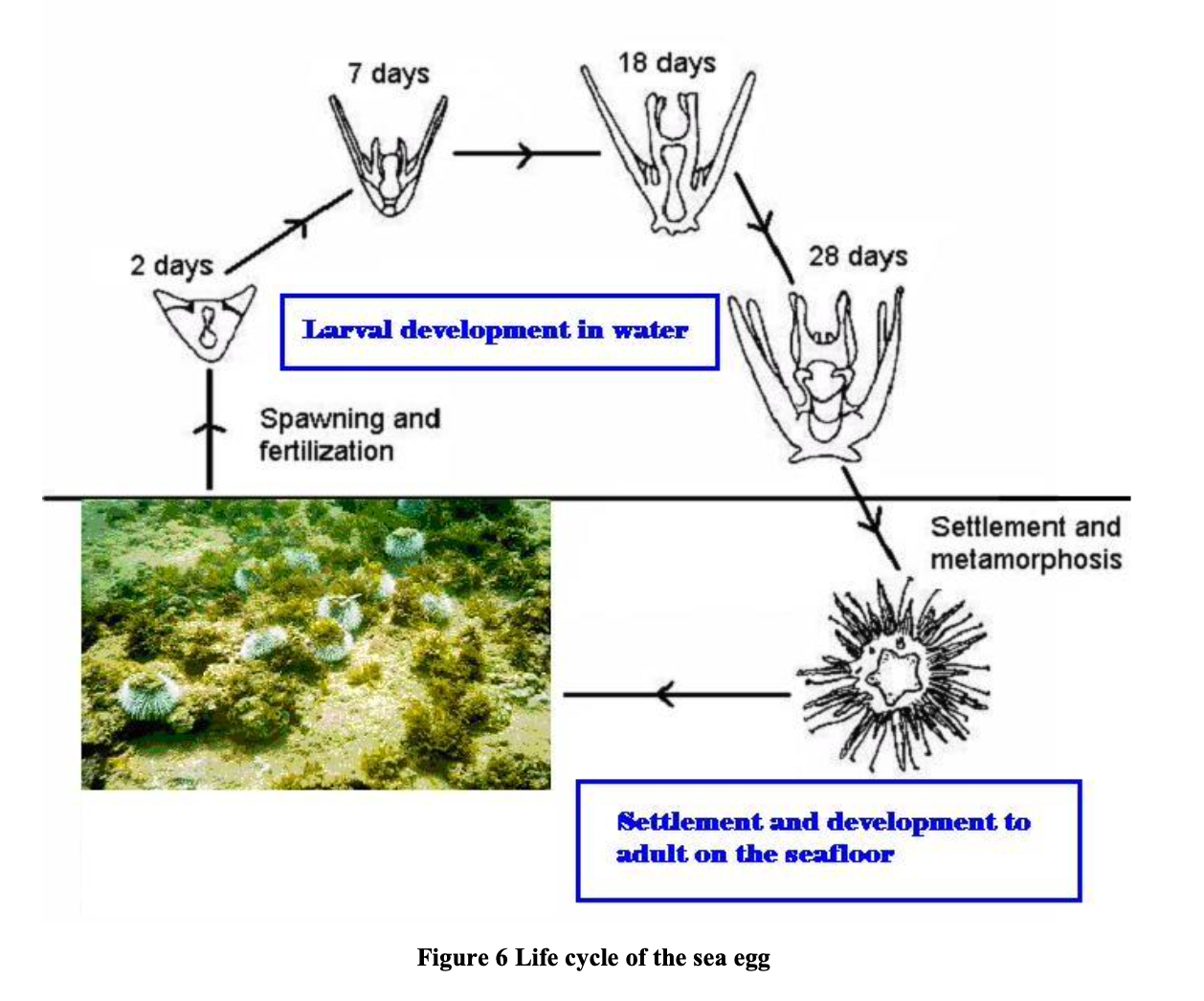
Every stage in the animals’ life cycle is important in determining how many adult sea eggs will be available for harvest. Some of the most important factors at each stage are as follows.
Spawning and fertilization stage
The number of fertilized sea egg eggs produced from a spawning event will be dependent on:
- The number of spawning adults and thus the number of eggs and sperm available.
- The fecundity of the spawning adults (i.e. how many viable eggs and sperm each has to offer).
- The proximity of the spawning adults to each other which affects the chances of
egg and sperm coming into contact with each other. The chances of contact between the gametes decreases with increasing distance between the spawning animals (figure 7). In addition, sperm in particular has a very short life once released into the water. As the chances of a sperm being able to fertilize an egg diminishes quickly with time.
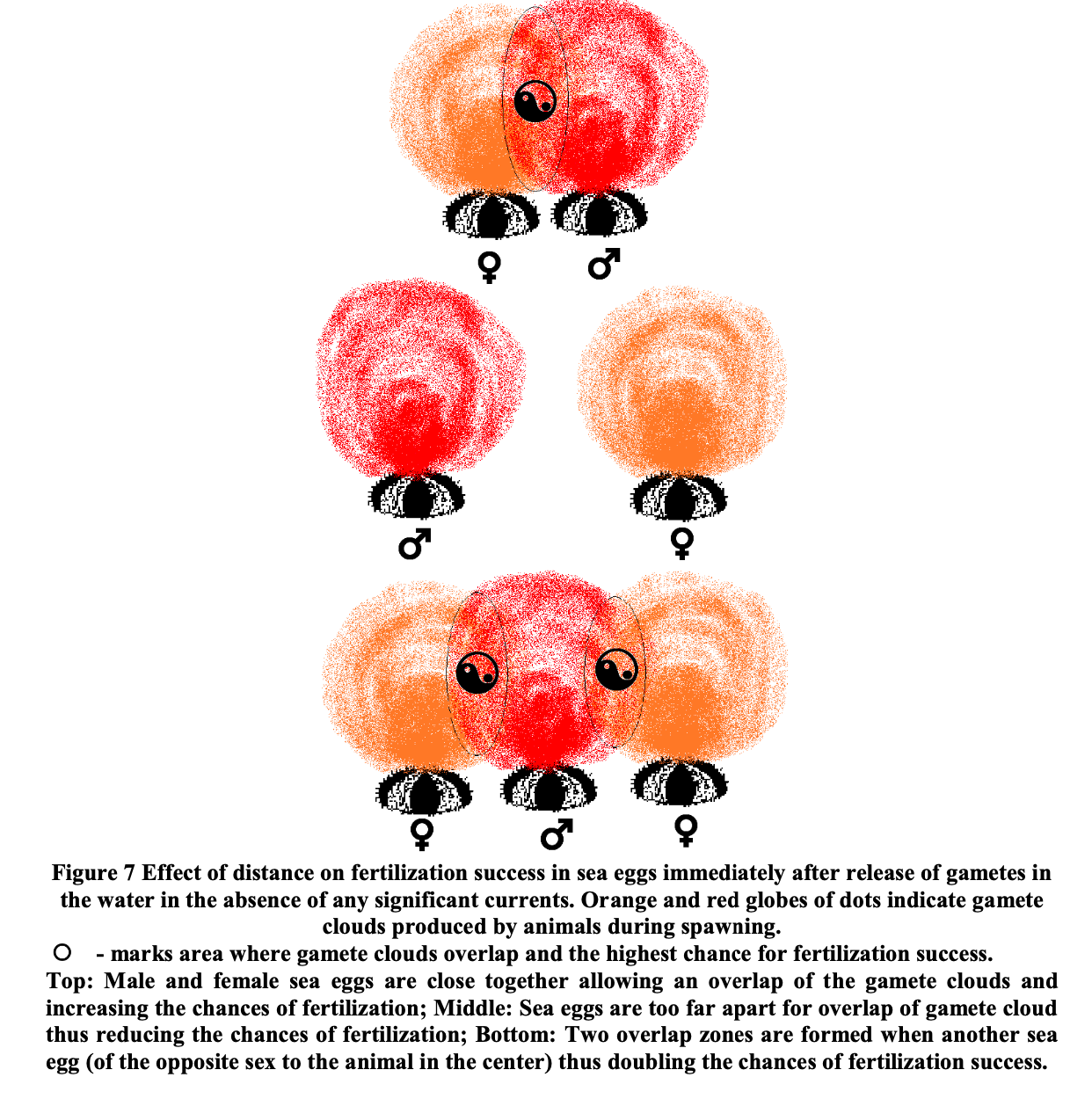
Under natural conditions the gamete clouds as illustrated in figure 7 would be exposed to prevailing water currents that would quickly distort their shape i.e. the currents may bend them into each other thus increasing the chances of contact or away from each other thus decreasing chances of contact. In time the cloud will also break up and the gametes will become scattered. In addition, it is likely that there would be a time lag between when each animal releases its gametes. These factors in combination impact significantly on how many eggs come into contact with sperm in time and thus the success of the spawning event. However, the chances of fertilization success and thus the conception of the new generation of sea eggs is greatly improved with increasing the numbers of breeding adults in a given area i.e. the density of adults.
Embryonic development in the water
How many sea eggs survive through this period, which lasts as long as 4 weeks, largely depends on the following factors:
- The level of predation in the water (i.e. how many are eaten by other animals in the water).
- The amount and quality of food available to the larvae once they start to feed.
- Ocean currents that transport the larvae and control if they are brought into areas where they can settle before they die.
- The condition of the water in which the animal lives such as temperature and presence of pollutants.
Settlement, metamorphosis and early juvenile development
At the final larval stage, the animal must come into contact with a suitable firm substrate to which it can attach itself and undergo the change (metamorphosis) into its more familiar benthic (bottom living) form. Following this change the small juvenile sea egg (figure 8) must find shelter to protect itself from predators and enough food to support its rapid growth. The speed at which the animal grows is important to its survival, as the risk of being attacked or eaten is greatest when it is small and decreases with increasing body size.
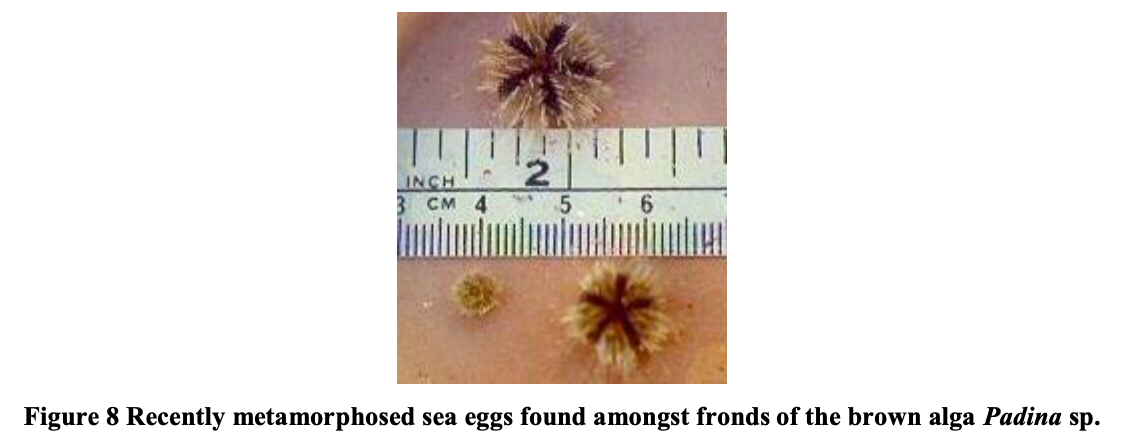
The number of animals passing through this phase therefore depends on:
- How many land in habitats that offer sufficient protection from predators.
- The amount and quality of food available to the juvenile animals necessary for their growth, development and health.
Juvenile to mature adult
The nutrition that a sea egg gets from the food it consumes must be channeled into three main areas:
- general bodily functions such as respiration, moving etc.
- body growth and
- its reproductive structures i.e. development of its sex organs (ovary or testes) and gametes (eggs or sperm).
Body growth in the sea egg slows down as its sexual structures develop.
Seaeggs feed on a variety of things including attached or drifting seaweeds, sea grasses and dead organic matter (Figure 9). The nutritional value of the diet is a major determinant of the body size that the sea egg attains before sexual maturity as well as how well its reproductive structures develop. Diet is therefore is a major determinant of the fecundity of sea eggs and consequently their spawning and fertilization success as already described. In Barbados, brown algae seem to be the best food for sea eggs especially in terms of gonad development.

Healthy gonad development is very important for the animal’s ability to reproduce and thus sustain stocks. While the sustainability of stocks is in itself very important for the fishery, good gonad size and quality is also directly important, as the gonads themselves are the commercial product of the fishery.
Sea egg gonads contain three important types of cells. These are:
- egg or sperm (gametes)
- cells that will develop into the eggs (oogonia) and sperm (spermatogonia)
- nutritive cells that provide energy for the development of the gametes.
The ratio of the cell types in the gonad controls its texture. The size of the roe is affected by the stage in the animal’s reproductive cycle. Which may be summarized as follows:
- (A) Upon reaching maturity the roe starts to appear first as a small structure.
- (B) The roe size increases first due to an increase in the number of nutritivecells. At this stage the roe is firm as in the sea egg in figure 1.
(C) As the gametes develop the proportion of nutritive cells decreases and they are replaced by a higher number of ripe and ripening gametes (oogonia or spermatagonia). At this stage the roe swells even larger as it becomes filled with the fluids needed to expel the gametes during spawning. At this stage the roe is runny and soft and sea eggs at this stage will often spontaneously spawn when handled (Figure 11).
(D) After spawning, the roe size decreases sharply sometimes only to the width of a string.
(E) Finally the roe rebuilds again with nutritive cells. This process is called repletion and it is only at this stage that harvesting should be allowed.
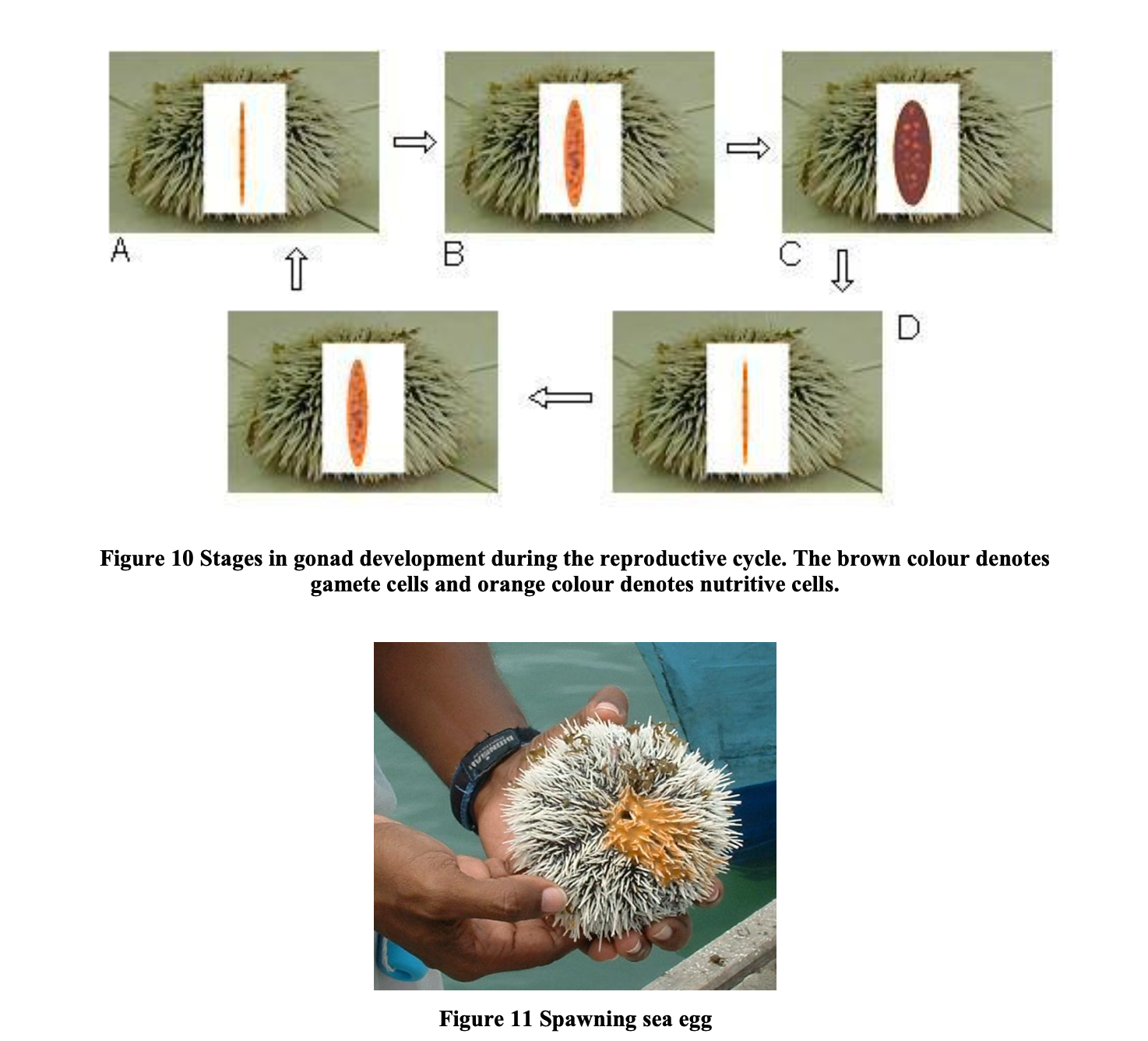
Sea eggs exhibit breeding synchrony so that animals are usually at the same reproductive stage as their neighbours. This is especially important at the time of spawning to increase fertilisation success. However, seaeggs at distant grounds may not be at the same reproductive stage. Sea eggs at one location around the island may have reached the harvestable stage, having gone through their maturation, spawning and gonad repletion phases, while the sea eggs at another site may still be at one of the earlier stages. It is therefore important to ensure that the sea eggs at each site have reached the appropriate phase and gonad size before harvesting. Experienced fishers are aware of this and traditionally test the gonad ripeness of a few animals before harvesting from the site. For management of the fishery on the whole it is advisable to time the harvest season such that most of the sea eggs around the island have reached the harvesting stage. To do this it is necessary to monitor gonad quality. As gonad size is also affected by nutrition, the state of the gonads also indicates how well the animals are doing in their natural habitats.
Implications of some key aspects of sea egg biology to the fishery and its management
By considering the life cycle of the sea egg and the numerous unpredictable factors that affect the animal’s survival particularly during its embryonic stages it should be clear that it is impossible to predict how many sea eggs will successfully recruit to the stock from year to year. Practical experiences with both local sea eggs and other sea urchin species worldwide all show this natural unpredictable recruitment. However, as already mentioned, it stands to reason that maintaining an adequate density of breeding adults enhances the chances for good juvenile recruitment. The unpredictability of recruitment makes it impossible to quantify exactly what is an “adequate” density for sustaining the Barbadian sea egg stock and indeed this limit will be expected to vary from year to year as other impacting factors will themselves vary.
Surveys on the local sea egg stock have been conducted annually since 2001 during the months just prior to the start of the annual fishing season. The principle purpose of these surveys is to assess the strength of the stock in the study year to determine the appropriate length of the fishing season. The first part of the survey is estimation of sea egg abundance and specifically average densities across a number of index sites around the island. The average densities in a particular year are compared with the average densities at the same sites in previous years and based on this information it is determined if the fishing season should be shorter or longer than that of the previous years. The primary aim of this exercise is to constrict the length of time allowed for fishing to prevent removal of most of the sea eggs thus leaving a number of reserve breeding adults for the next years breeding season.
The second part of the surveys involves the collection of data on the size structure of the stock. The first stage of this assessment involves measuring the diameters of a sample of the animals at each site. The measurements of the sampled animals within the same size ranges may be grouped together e.g. in the sample there may be 20 sea eggs falling between 61 and 65 mm in diameter, 40 between 66 and 70 mm in diameter etc. This information may be plotted in a graphical form for each site allowing simple pictorial representations of the size distribution of animals at each site to be easily compared (figure 12).
Some very important information may be obtained from these studies. The first is if juvenile recruitment has occurred at the site and the strength of that recruitment. For example, in figure 12, note that there are two distinct size groups of sea eggs in the graph on the left (the size distribution of sea egg at site A) and only one group in the graph on the right (the size distribution of sea eggs at site B). This shows that two distinct pulses of recruitment had occurred at site A and only one recruitment pulse had occurred at site B by the time these surveys were conducted.
As already explained, the body size of a sea egg is affected by the quality of the nutrition it has obtained during its lifetime. Therefore, the quality of a specific site is reflected in the sizes of the sea eggs living there. In figure 12, it appears that the animals in the single size group observed at site B (graph on right) approximately fall within the same size range of the smaller animals in the smaller (presumably younger) size group at site A (graph on left). The first conclusion would be that all the animals at site B are about the same age (i.e. were recruited at the same time) as the animals in the smaller size range at site A. In fact, prior knowledge of these sites indicates that the animals at site B were the same age as the older animals at site A. Marked differences in habitat quality had actually stunted the growth of the animals at site B. In addition, there had been no second pulse of recruitment at site B as had occurred at site A.
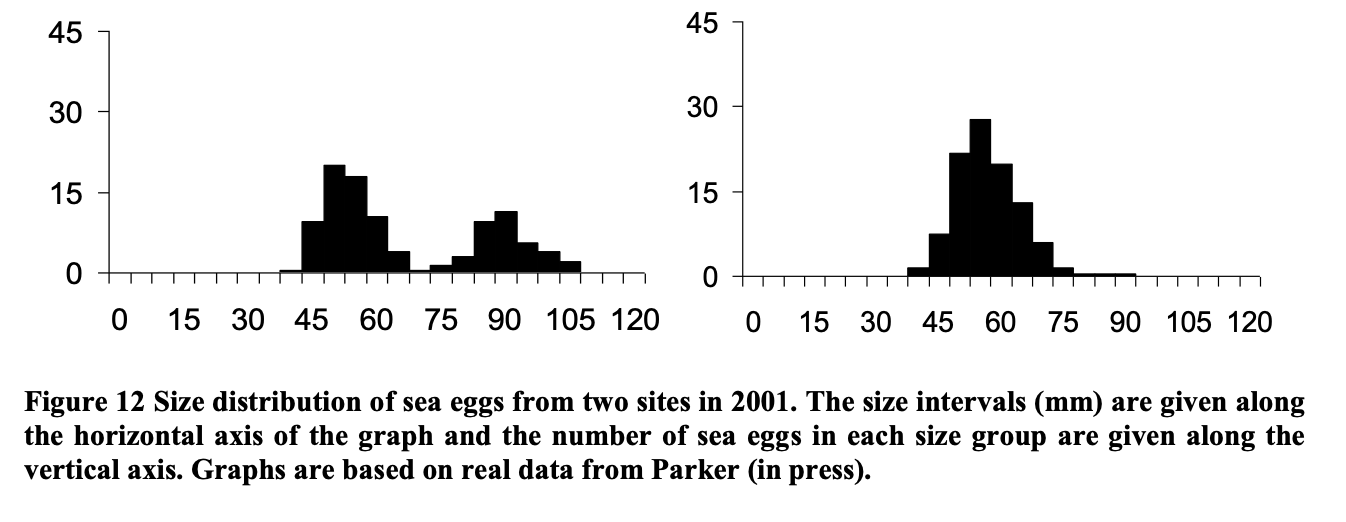
The third study to be undertaken is an assessment of the reproductive status of the animals. The majority of this work will be done in the laboratory on samples of animals taken from the index sites. Such information is useful for ascertaining the best time to allow fishing both in terms of pin-pointing when the gonads are at the peak of their productivity from a marketing perspective (i.e. late in the repletion stage). In addition, as mentioned earlier the size of the gonad also indicates how well the animal is doing from a nutritional perspective.
In the longer term it is hoped that these studies will facilitate a better understanding of the ecology and biology of local sea eggs. This will be useful for improving the management of the fishery.
